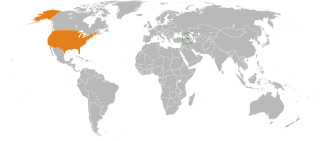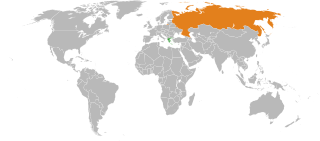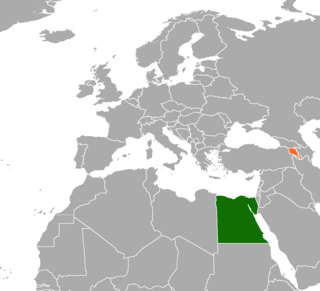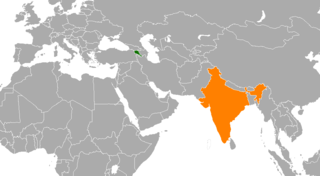
Since its independence, Armenia has maintained a policy of trying to have positive and friendly relations with Iran, Russia, and the West, including the United States and the European Union. It has full membership status in a number of international organizations, such as the Council of Europe and the Eurasian Economic Union, and observer status, etc. in some others. However, the dispute over the Armenian genocide of 1915 and the ongoing Nagorno-Karabakh conflict have created tense relations with two of its immediate neighbors, Azerbaijan and Turkey.

Relations between Armenia and Germany, have always been stable and solid, with both countries continuing to work together and advance through the years in cooperation. Both countries' leaders have discussed bilateral relations and noted that they have considerably improved over the last few years.

The dissolution of the Soviet Union in December 1991 brought an end to the Cold War and created an opportunity for establishing bilateral relations between the United States with Armenia and other post-Soviet states as they began a political and economic transformation. The United States recognized the independence of Armenia on 25 December 1991, and opened an embassy in Armenia's capital Yerevan in February 1992.

People's Republic of China has an embassy in Athens. The Hellenic Republic has an embassy in Beijing and three general consulates in Guangzhou, Hong-Kong and since 2005 in Shanghai. The Port of Piraeus is important from a geostrategic view for China, as it helps China's transactions with the whole of Europe. Thousands of Chinese people are living in Greece in the Overseas Chinese context and approximately 1000 Greek citizens are living in China. Modern diplomatic relations between the two countries were established in 1972. Today, Greece and China enjoy a very good relationship based on a solid foundation, which continues to be growing steadily.

Greco-Russian relations are the bilateral foreign relations between Greece and Russia. The two countries first entered into diplomatic relations in 1828. Both Greece and Russia are members of international organizations and agreements, including the United Nations, Organization for Security and Cooperation in Europe, and the Organization of the Black Sea Economic Cooperation.

Foreign relations exist between Armenia and Egypt. Egypt was one of the first countries in the Arab world which recognized the independent Armenia in 1991. In March 1992, the diplomatic relations were established between the two countries. In May 1992, the first diplomatic mission of Armenia in the Arab East was inaugurated in Cairo. Egypt has an embassy in Yerevan.

The Armenian community in Argentina is the largest in Latin America totaling approximately 120,000 members.

Foreign relations exist between Armenia and Bulgaria. Both countries have had diplomatic relations since they were established in 1992. Armenia has an embassy in Sofia; since December 19, 1999, Bulgaria has an embassy in Yerevan. Both countries are full members of the Organization of the Black Sea Economic Cooperation and the Council of Europe.

International relations between Armenia and India have been described as amicable. In 2022, it was reported that the two nations were exploring the possible of long-term military cooperation.

Bilateral relations exist between Armenia and Serbia. Diplomatic relations between Armenia and the Federal Republic of Yugoslavia were established on 14 January 1993; Serbia is the legal successor to this country. Both countries are represented through their embassies in Athens, Greece, and both have established honorary consulates, which serve as the only diplomatic representatives between the two countries.

Foreign relations exist between Armenia and Uruguay. Uruguay, as a small South American nations hosts a large Armenian community for its size. The Armenian community in Uruguay totals approximately 16,000 people.

Diplomatic relations exist between Armenia and Canada. Both nations are members of the Organisation internationale de la Francophonie and the United Nations.

Egypt–Greece relations refer to bilateral relations between Egypt and Greece. Due to the strong cultural and historical ties between the two nations, Egypt and Greece today enjoy friendly relations. Modern diplomatic relations between the two countries were established after Greece gained its independence in 1830, and are today regarded as cordial. Both countries are members and partners in several international organizations such as UN, IMF, OSCE, and the Union for the Mediterranean.

Foreign relations have reportedly always been strong between Armenia and Cyprus. Cyprus has been a supporter of Armenia in its struggle for the recognition of the Armenian genocide, economic stability and the resolution to the Nagorno-Karabakh conflict. In return Armenia has been advocating a stable Cyprus after the Turkish invasion in 1974 and supporting a lasting solution to the Cyprus dispute.

Foreign relations exist between Armenia and China. The first references to Armenian-Chinese contact are found in the works of 5th-century historian Moses of Chorene and 6th-century geographer and mathematician Anania Shirakatsi. The People's Republic of China officially recognized Armenia on December 27, 1991. Diplomatic relations between Armenia and the People's Republic of China were established on April 6, 1992. The Embassy of China to Armenia was established in July 1992, while the Embassy of Armenia to China started its activities on August 10, 1996. The Armenian Ambassador to China resides in the Beijing embassy.

Diplomatic relations exist between Armenia and Mexico. Both nations are members of the United Nations.

Relations between Armenia and Brazil, have existed for decades. The Armenian community in Brazil is the second largest in Latin America totaling approximately 100,000 members.

Armenia–Spain relations are the bilateral relations between Armenia and Spain. The importance of relations centers on the history of Armenians migration to Spain. Approximately 40,000 Armenians and their descendants reside in Spain. Both nations are members of the Council of Europe.

Diplomatic relations exist between Armenia and Chile. There are over 600 Armenians and descendants residing in Chile today. Both nations are members of the United Nations.

Armenia–United Arab Emirates relations are the diplomatic relations between Armenia and the United Arab Emirates. Official relations exist between both nations since 1998. Armenia has an embassy in Abu Dhabi and a consulate in Dubai. The United Arab Emirates has embassy in Yerevan.






























